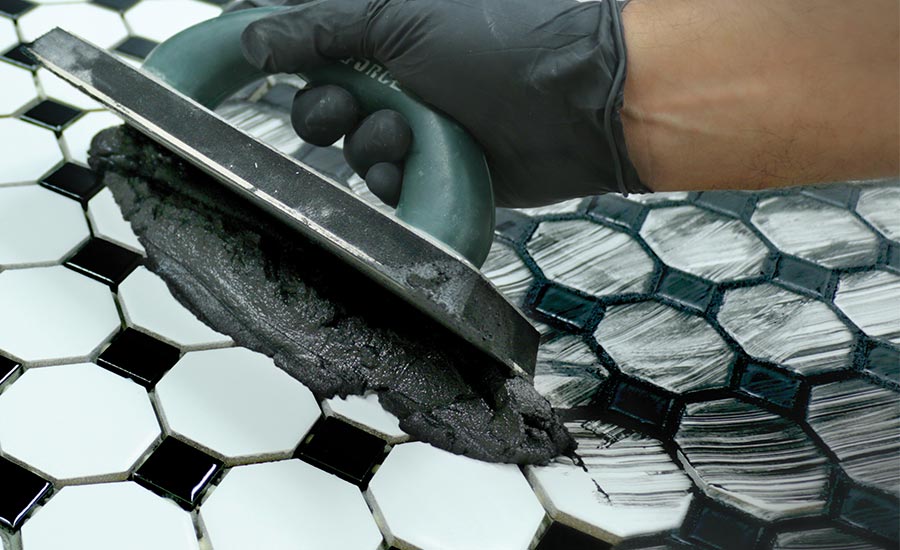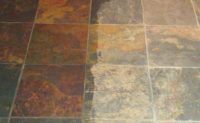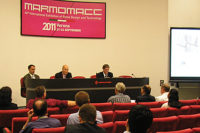One of the most common questions regarding the sealing of tile, grout and natural stone is, "Do we need to seal?" The answer is that all stone and tile products --even porcelain tile --benefits from sealing. There is a broad range of elements that can penetrate or hold to the surface, including grout, dyes, polyester resins, epoxy resins, oil, water, etc.
Many products on the market have been designed to beautify and "protect" the surfaces of stone, tile and grout, including sealers, finishes, color enhancers and waxes. As the name implies, sealers actually seal the surface tight against chemicals, water and other contaminants. Normally, a finish is placed on top of a sealer. Sealers typically are not vapor permeable and can be semi-permanent and hard to repair.Sealers can be water-based or solvent-based. Most water-based sealers cannot be used outside.
Finishes
Finishes are coatings that incorporate acrylic polymers, synthetic polymerized waxes and natural waxes. These products form a hard, transparent film. They are typically applied to a surface after it has been sealed. The solids content normally dictates cost. Finishes range from 8 to 38% solids content. The higher the solids, the more difficult to use, and the more expensive it is.
Most finishes in high-traffic areas require daily maintenance of cleaning, mopping and restoring with a high-speed buffing. Typically, finishes have a limited life span of a few weeks to one year before complete stripping and re-coating is required. Stripping of sealers and finishes can do much of the damage associated with top coating natural stone.
Finishes are normally used inside away from sun, wind and rain. Typically, finishes are hard to repair and must be stripped or re-coated. They also lack vapor permeability.
Waxes
Waxes are normally comprised of naturally occurring elements such as carnuba, montan, ozokorite and beeswax. These elements are heated and emulsified to desired solids content ranging from 8 to 40%. Waxes are soft materials and require buffing to obtain gloss. Waxes have low durability and may require multiple applications. Most waxes are vapor permeable and can be easily applied and repaired when scratched or damaged.
Color enhancers
These products are topical coatings in the truest sense of the word. Typically, these products are acrylics and modified acrylics with lower solids and lower viscosity. They tend to penetrate more deeply than a traditional topical coating. Color enhancers can also be more durable, allow vapor transmission and many can be used outside in the elements. As with most products, color enhancers are available in both solvent-based and water-based formulas.
Stripping coatings
In most instances, solvent-based coatings are not compatible with water-based coatings. In addition,
it typically takes a solvent-based stripper to remove a solvent-based coating and a water-based stripper to remove a water-based coating. It is important to keep similar chemicals applied to the same surface. Should a mix occur, an adhesion challenge may take place and although it may look and feel correct, the end result will cause the coatings to separate.
Impregnators/penetrating sealers
These products are surface treatments that will not change the natural look of the substrate. Impregnators will not show scratching or scuffing and do not require constant attention to maintain the quality of finish. Re-application of an impregnator can range from six months to 20 years, depending on the manufacturer, substrate and surface location.
Impregnators are typically low molecular weight polymers formulated to penetrate below the surface. To accomplish this feat, monomers are simply hydrolyzed in the presence of solvent or water. The low viscosity allows complete wetting of the particles or fibers within the given substrate. When the carrier of solvent or water evaporates, the impregnator reacts to leave a long-lasting, invisible barrier of protection from the elements.
There are three basic ways the impregnator works. With water-based impregnators, the water evaporates and leaves behind a film. This film changes the angle of contact between liquid and the solid surface that has been treated. The greater the angle of contact between the liquid and the solid, the more difficult it is to penetrate the solid.
The impregnator film also reduces surface tension, making it more difficult for most liquids to penetrate the solid surface. This change in surface tension also creates the "beading" action that customers are so fond of.
With solvent-based impregnators, there is an added benefit of a cross-link phenomenon that creates a "barrier." This added barrier virtually eliminates any penetration of liquids.
For these three reasons, products that best protect stone and tile against water and oil stains contain complex and unique polymers and co-polymers.
Solvent-based impregnators vs. water-based impregnators
The only way to protect the substrate is to penetrate it with something that will carry the protection into it. The protection can come from silicones, silanes, siloxanes and various polymers and co-polymers. Nevertheless, it has to be carried into the substrate, and it will typically use one of two carriers: solvent or water.
Typically, solvents will allow varied and deeper penetration into the substrate than water. The curing process, which is a result of evaporation, can be adjusted by using different solvents. Solvent-based impregnators can be cross-linked, allow a wider temperature window for application, have better durability, and are typically unaffected by exposure to cold during application, storage and shipment.
Water is hydroscopic and will hold out on the surface. The protection cannot penetrate any deeper than the water will. The protection can only be in place when the water evaporates. For many dense surfaces, like porcelain tile and polished granite, water will not penetrate very deeply (if at all) and the protection is left at the surface with poorer durability over the long term. Any polymer can be emulsified, but unlike solvent-based products, water-based products cannot be cross-linked to give best performance.
Water-based products are typically lower in toxicity and have little or no smell as compared to similar solvent-based products. Contrary to some beliefs, water-based products are no easier to use or apply than comparable solvent-based products. In some instances, they can present difficult challenges when removal is necessary.
Different protection sources
The most common protection sources of an impregnator come from the silicone family and the fluropolymer family. Silicones are any group of semi-organic polymers containing chains of alternate silicon and oxygen atoms, characterized by wide-range thermal stability and used in adhesives, lubricants, protective coatings and synthetic rubber. Silicones can actually last longer that the substrate they have been applied to. Unaffected by outside elements, they can only be damaged by temperatures of +900 to +1,200 degrees F or by exposing them to a very strong caustic solution.
Co-polymers and fluropolymers are relatively new to the tile and stone industry. Usually, these products consist of long-chained molecules that contain fluorine and carbon. Because fluorine is electronegative, it is not found occurring naturally in the earth. Rather, it is always combined with something else. By extracting fluorine and then combining it with carbon, one can achieve many desired properties when such a material is applied to a substrate. These raw materials have been utilized in the fabric and textile industry for many years.
As a rule, silicone-type products repel water very well and are weaker at oil repellency, and fluropolymer-type products are weak at repelling water but good for repelling oil. It is difficult to achieve both, and most products on the market sacrifice in one area or the other. Research will find that just a few products that actually work well at repelling both elements over the long term.
Do not be misled by the unit cost of the product you are considering. There is a wide range of prices on the products available. We suggest using the cost-per-square-foot to determine which product is more expensive. If one product sells for $30 per gallon and covers 100 square feet per gallon, and another product costs $200 but covers 1,000 square feet per gallon, which is actually less expensive?
To ensure that a product will perform as promised, request independent backup for all claims made by any company. It is very simple for manufacturers to supply their products to independent labs for testing. If the results favor the specific needs of an application, then test the products yourself.
Which surfaces benefit?
Surfaces that will benefit include: grout, quarry tile, ceramic tile, some glazed tile, some porcelain tile, marble, granite, travertine, limestone, slate, brick, terrazzo, quartz, sandstone, flagstone, concrete, masonry, saltillo, terra-cotta, cantera and all types of natural and cast tile and stone products.
An impregnator will resist water, oils, grease, mold, mildew, algae, efflorescence, graffiti, grout dyes, epoxy grout film, cement grout film, mortar haze, acid rain, atmospheric dirt, lime deposits, soap scum and other penetrating items. In addition, many impregnators make the surface less slippery, harder, and allow 100% vapor transmission.
It is also important to note that while kitchens and restrooms represent approximately 10% of a facility, they are used by 100% of the occupants and visitors and cause more than 80% of the facility complaints. This is an important factor when considering that these areas typically utilize stone and tile.
Uses for impregnators include but are not limited to: grout release, kitchen floors and counters, showers, baths, driveways, pool areas, garages, restaurants, cafeterias, grocery and meat markets, loading dock areas, exterior walkways (to minimize damage associated with freeze/thaw) and buildings exteriors (to resist weather and acid rain). In addition to residential applications, sealers have been successfully used at hospitals, schools, government facilities, airports, train and bus stations, hotels, quarries, industrial plants, laboratories, service stations, bridge abutments, historical sites and shopping malls.






